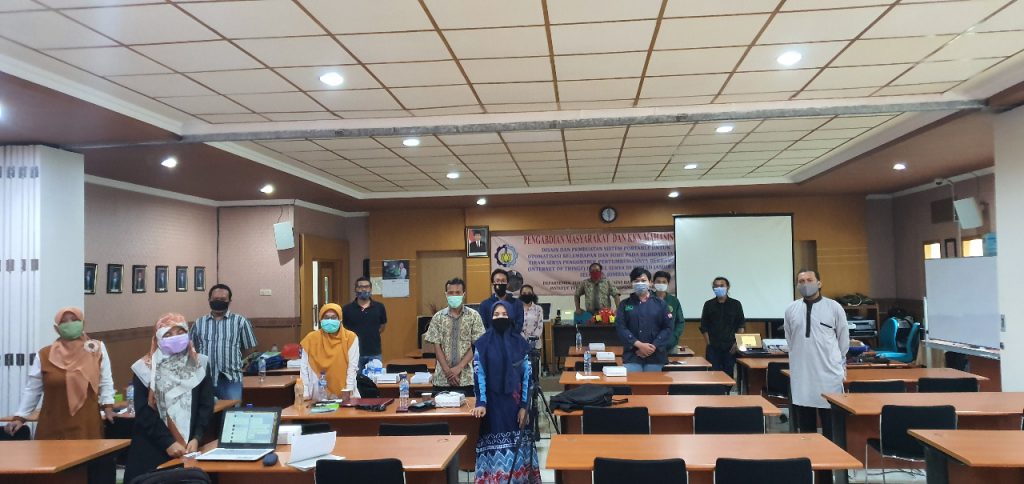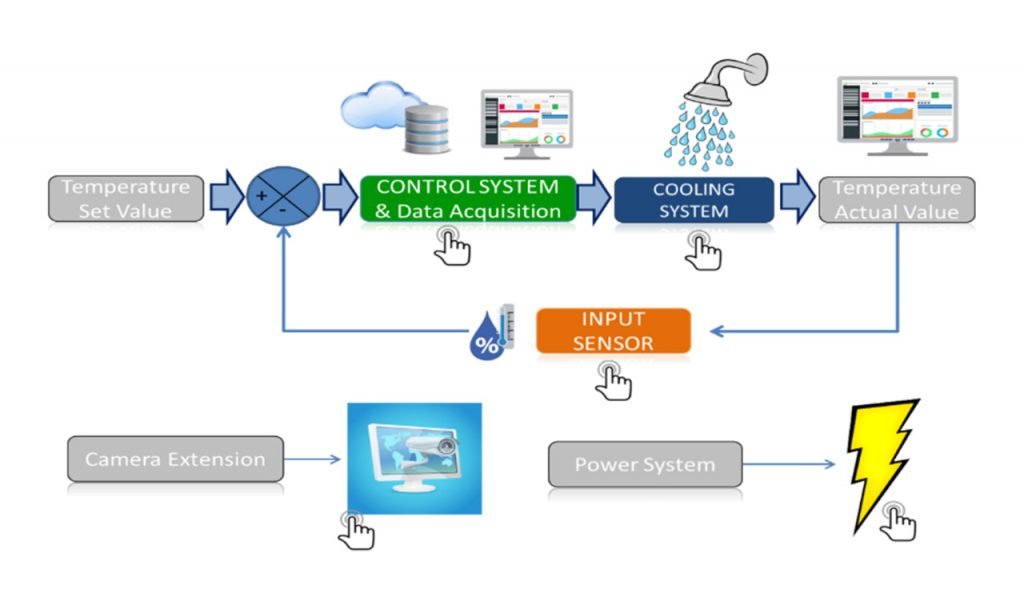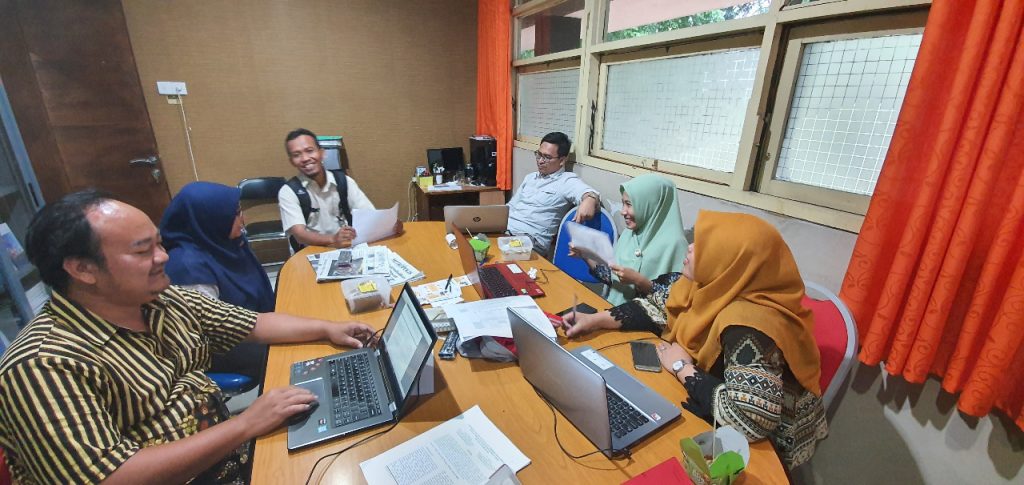ITS Creates Oyster Mushroom Cultivation Moisture and Temperature Automation Tool

Dr Lila Yuwana SSi MSi (center, red mask) with KKN team at Selorejo Village mushroom house, Jombang
ITS campus, ITS News – Cultivating oyster mushrooms requires certain ecosystem conditions that are quite difficult to maintain optimally. However, this is no longer a problem, because lecturer of ITS Dr Lila Yuwana SSi MSi with his team in community service (Abmas) and Student Community Service (KKN) created a system design for the automation of moisture and temperature cultivation of oyster mushrooms.
Located in Selorejo Village, Jombang, this KKN activity will last until December 10, 2020. Selorejo village has quite a massif furniture production activity, so many of it produce teak wood waste from its process. This condition was then utilized by KKN ITS Team to try to cultivate oyster mushrooms in Selorejo Village in 2019.
Seeing the success of the KKN activity, Lila thought to be able to further enhance the existing oyster mushroom cultivation activities. That is, by building a system that helps make it easier for the local community to manage the mushrooms.

Provision to KKN ITS participants on moisture and temperature automation system for oyster mushroom cultivation
It is said by Lila that oyster mushrooms will grow optimally if they are in an environment with a room temperature about 27 to 28 degrees Celsius. To keep the ecosystem in the temperature range, it is necessary to monitor periodically which is quite troublesome for oyster mushroom farmers. “In order for the optimal yield and high selling value, innovation is needed in the form of moisture and temperature automation system in the process of cultivating oyster mushrooms,” explained the Head of The Laboratory of Theoretical Physics and Natural Philosophy of ITS.
In the system built by Lila and the team, there are three kinds of watering methods that can be done to maintain the temperature of the oyster mushroom ecosystem. The first way is watering integrated with humidity and temperature sensors. When the state of the ecosystem is not in ideal conditions for oyster mushrooms, sprinklers automatically flush water in the form of fog to get the whole room back to room temperature.
The second way is timer-based spraying. This type of spraying will be carried out periodically according to the timer stipulated by the user. The last is a manual way, in which oyster mushroom farmers can activate spraying if deemed necessary manually. “Because this system relies heavily on internet connection, so to overcome the possibility of bad networks provided power buttons for activation,” said this lecturer of the Department of Physics ITS.
In addition to the automated spraying, Lila mentions that the system is equipped by a webcam to monitor oyster mushrooms remotely. Unlike rice plants that have a certain harvest period, oyster mushrooms can be harvested at any time when they are already large and shaped. If the mushrooms have been chewed and not picked immediately, then the oyster mushrooms will yellow and the quality is no longer good.
Dr. Lila Yuwana SSi MSi (left) coordinates with five other lecturers on the community service team and KKN ITSTo perform watering and surveillance functions on this moisture and temperature automation system, electric power is required. However, in the existing condition of the location of mushroom houses has not been flowed electricity from the State Electricity Company (PLN). So it is necessary to add solar panels as an alternative energy provider in the system.
“The solar panels we designed are portable so they can be moved easily. If necessary to find the power of solar panels can be expelled, then put in the mushroom house afterward,” explained the lecturer who has the field of expertise physics theory.
Lila revealed that in the realization of this KKN program there are unexpected things related to the oyster mushroom watering system in Selorejo Village. In existing conditions, usually the mushroom farm’s owner flushes their oyster mushrooms by going back and forth carrying water from a nearby river. But the path that must be taken is quite challenging and has the potential to cause people to slip.

Automated spraying system workflow with moisture and room temperature detection methods
So the KKN team was required to find a solution from water procurement to water this oyster mushroom. In response to this problem, Lila and her KKN team finally created a drill well that was integrated with the system she had designed so that there was no need to bring water back and forth from the river anymore. “This has an effect on the provision of the necessary power because the drill wells that are needed are quite consuming large amounts of power due to the deep distance to the groundwater,” she said.
Getting a positive response, Lila intends to continue the development of oyster mushroom potential in Selorejo Village at KKN activities in 2021. Oyster mushrooms harvested today are still simply processed into one type of processed oyster meatballs. Lila’s ambition going forward is to add a more varied type of oyster mushrooms, help manage halal certification, to trademark manufacturing and marketing platforms to help improve the local economy. (ram/Anjani/ITS PUBLIC RELATIONS)
Related News
-
ITS Rises to Second Rank in Most National PKM Funding
ITS Campus, ITS News – Strengthening its determination in the scientific field, the Institut Teknologi Sepuluh Nopember (ITS) succeeded
October 19, 2020 18:10 -
Examining Kenny, the Best ITS Bachelor Graduate with a GPA of 3.94
ITS Campus, ITS News — Educating for 3.5 years at the Institut Teknologi Sepuluh Nopember (ITS) did not prevent Benedictus
October 19, 2020 18:10 -
Inspirational, Deaf ITS Graduates Graduated with Cumlaude Predicate
ITS Campus, ITS News — An inspiring story was also present at the 129th Graduation Ceremony of the Institut Teknologi
October 19, 2020 18:10 -
129th Graduation: ITS Graduates 1,355 Candidate Leaders
ITS Campus, ITS News – Institut Teknologi Sepuluh Nopember (ITS) again held a graduation procession for its students through the
October 19, 2020 18:10

